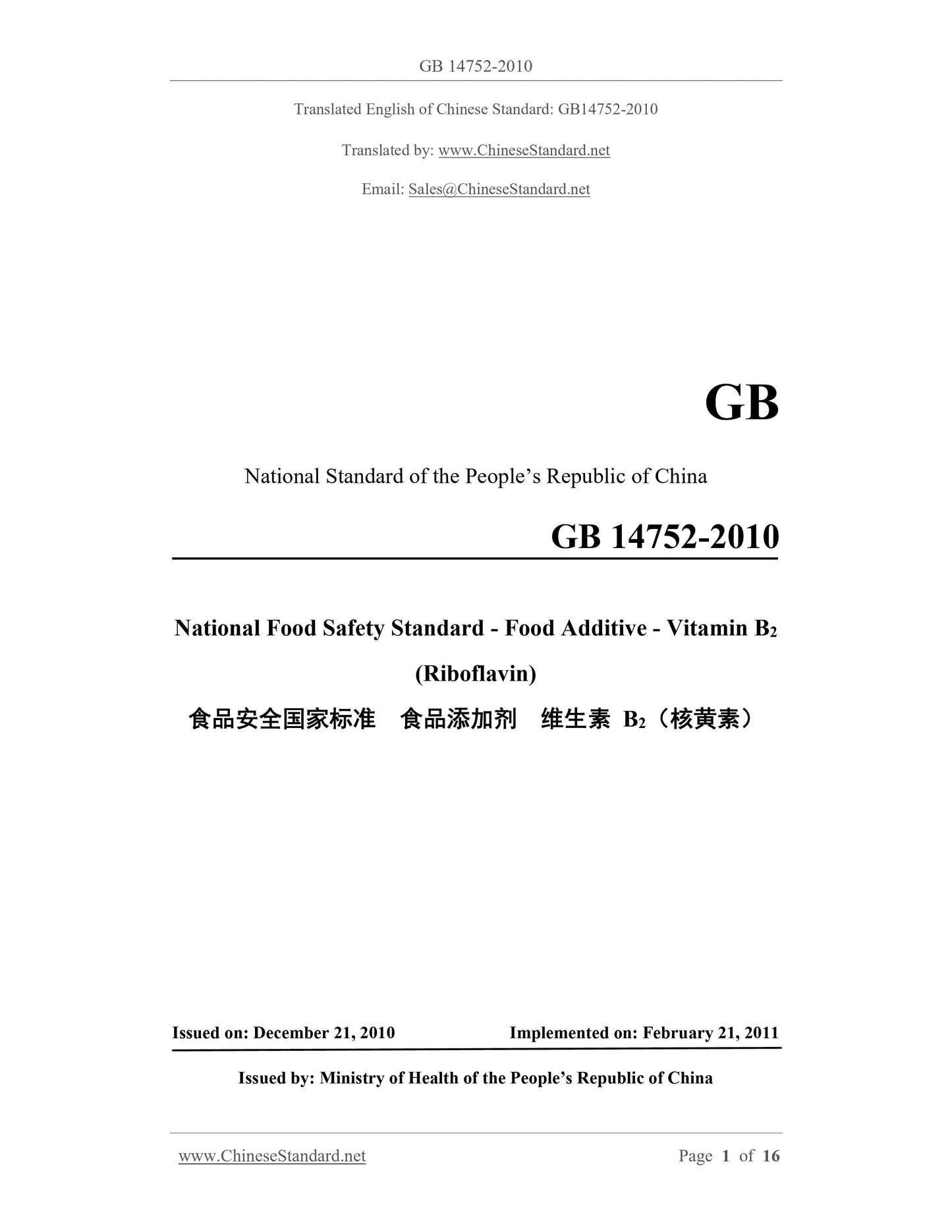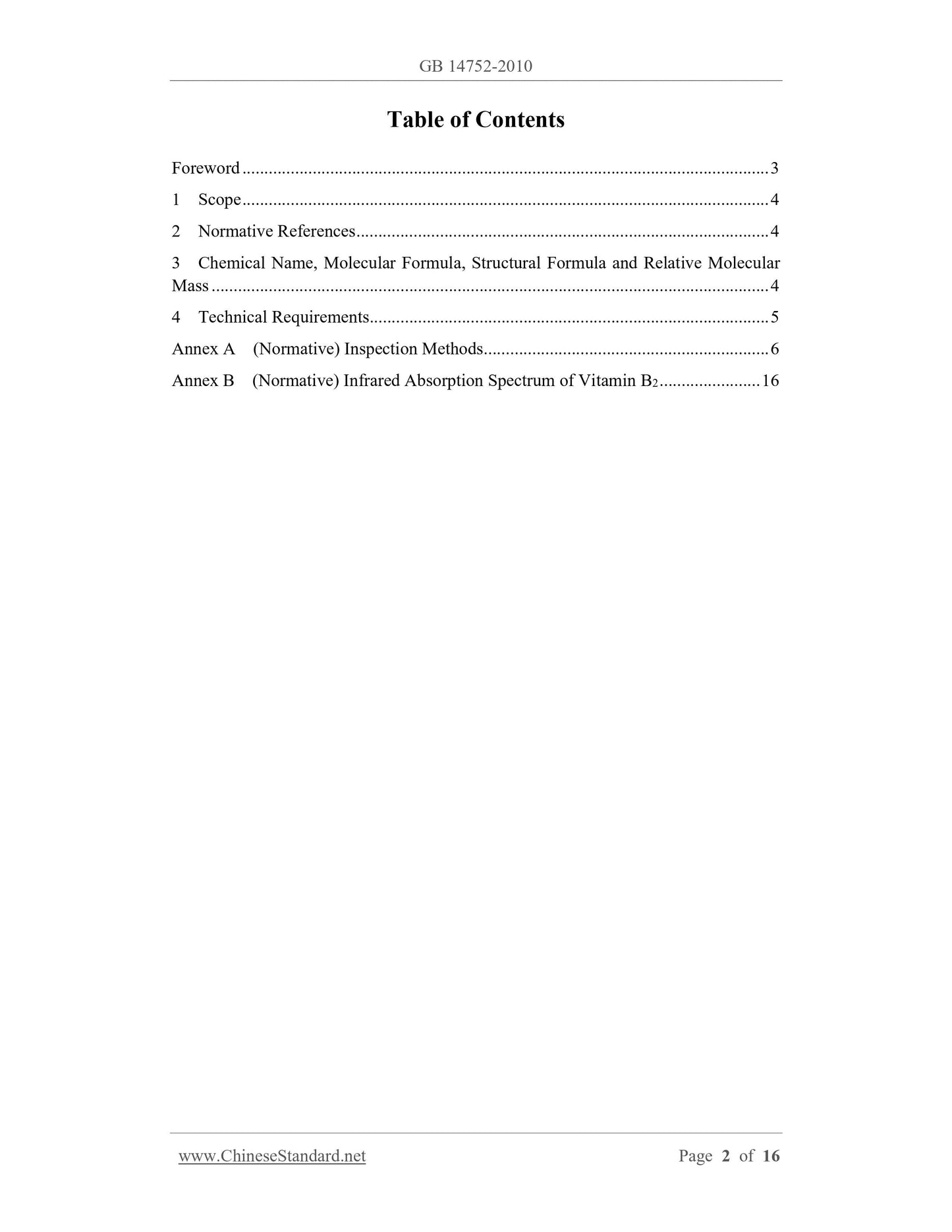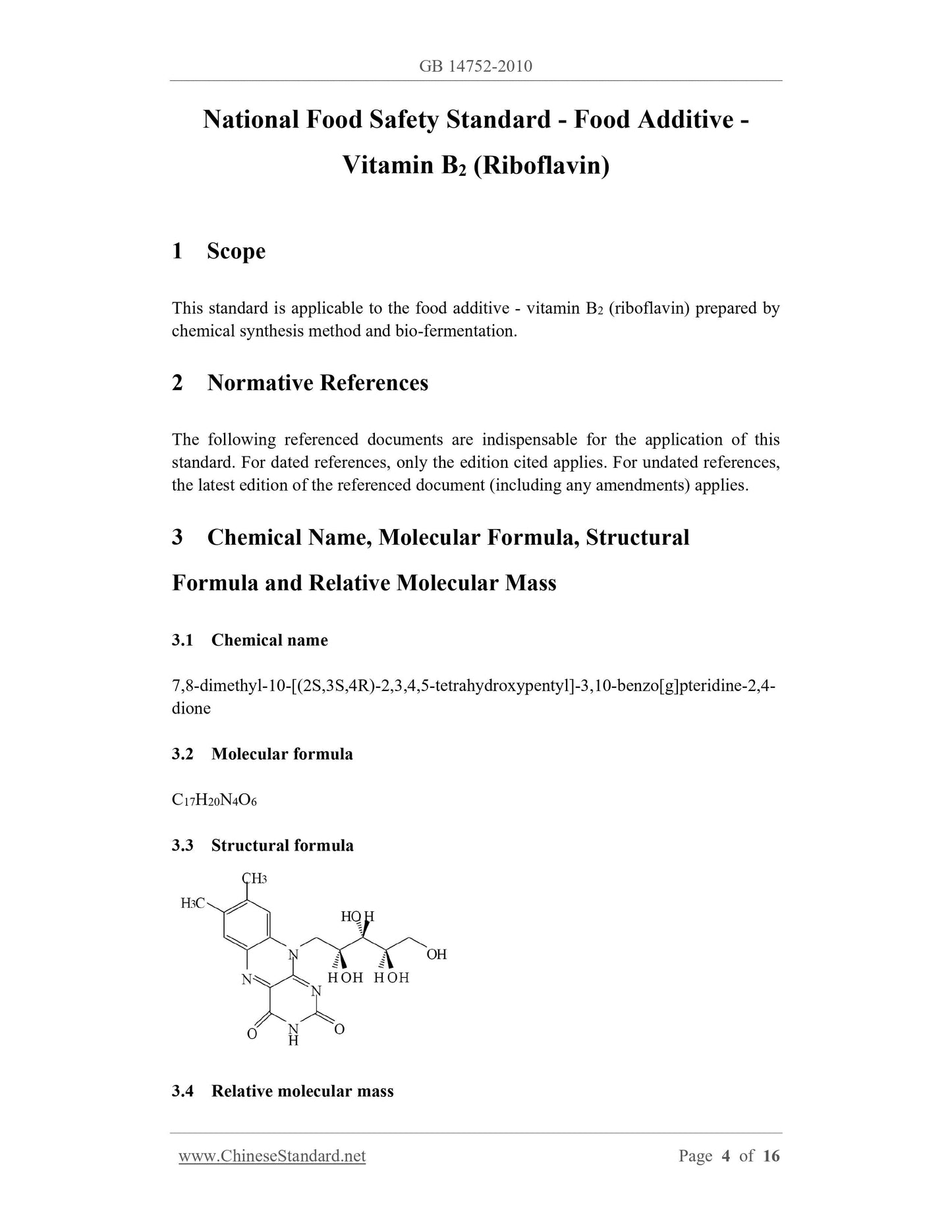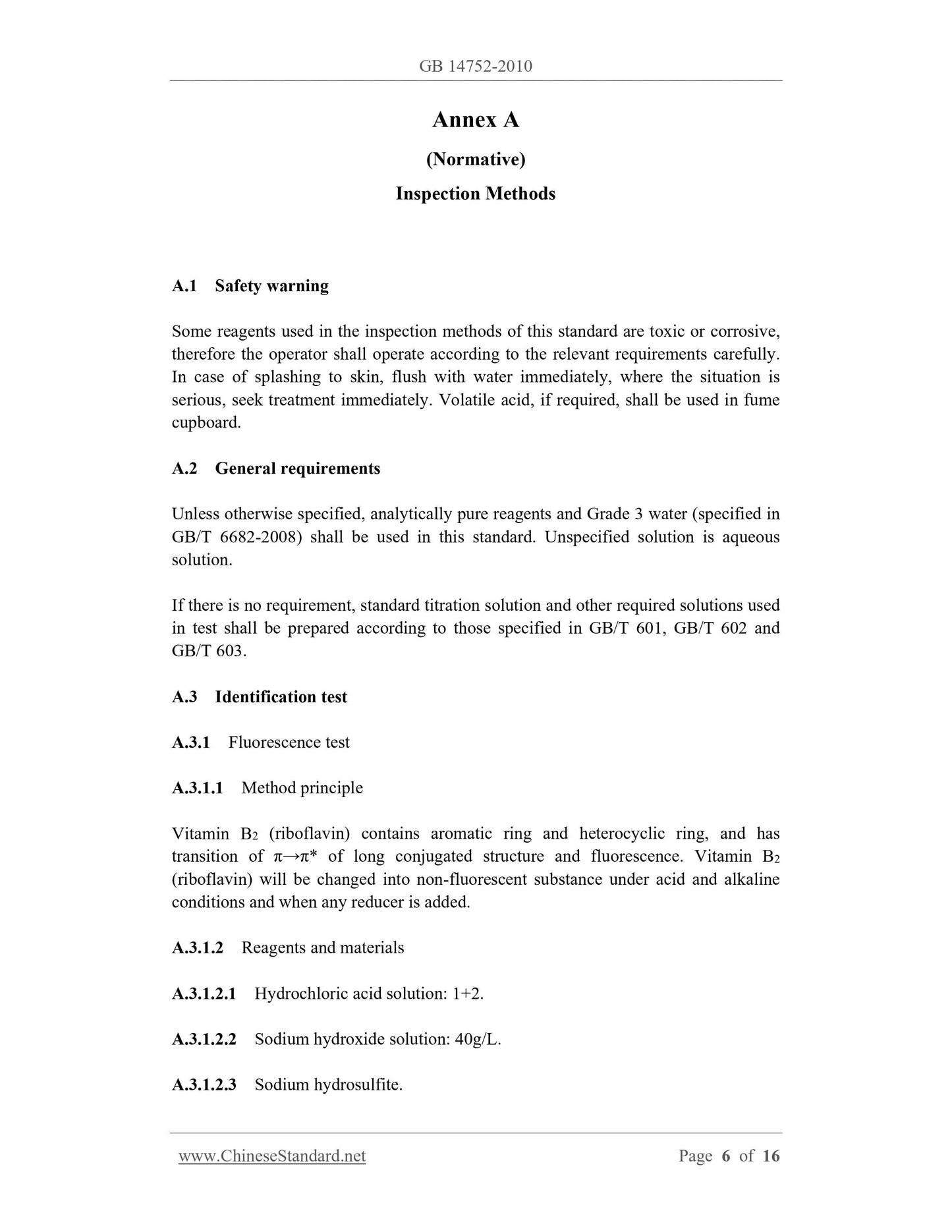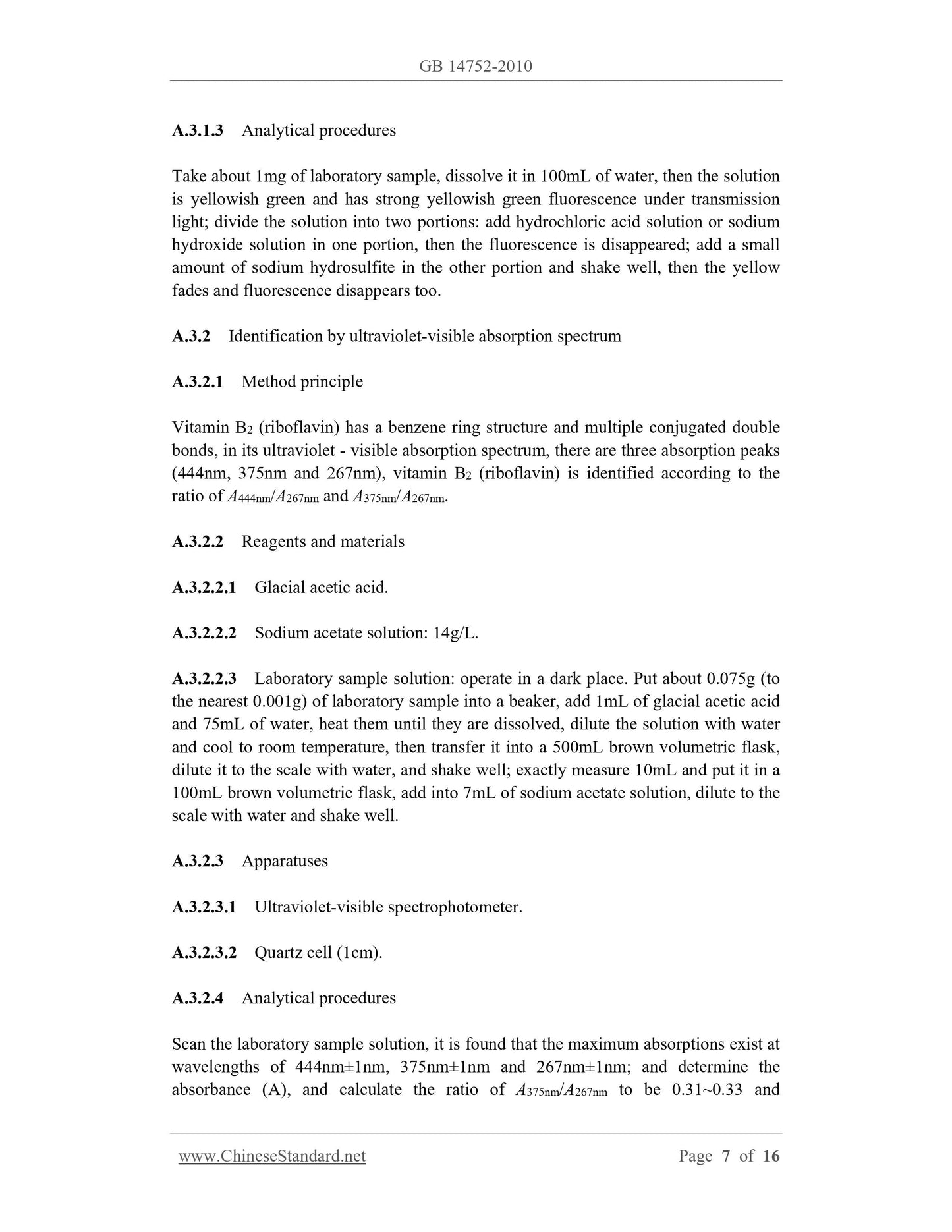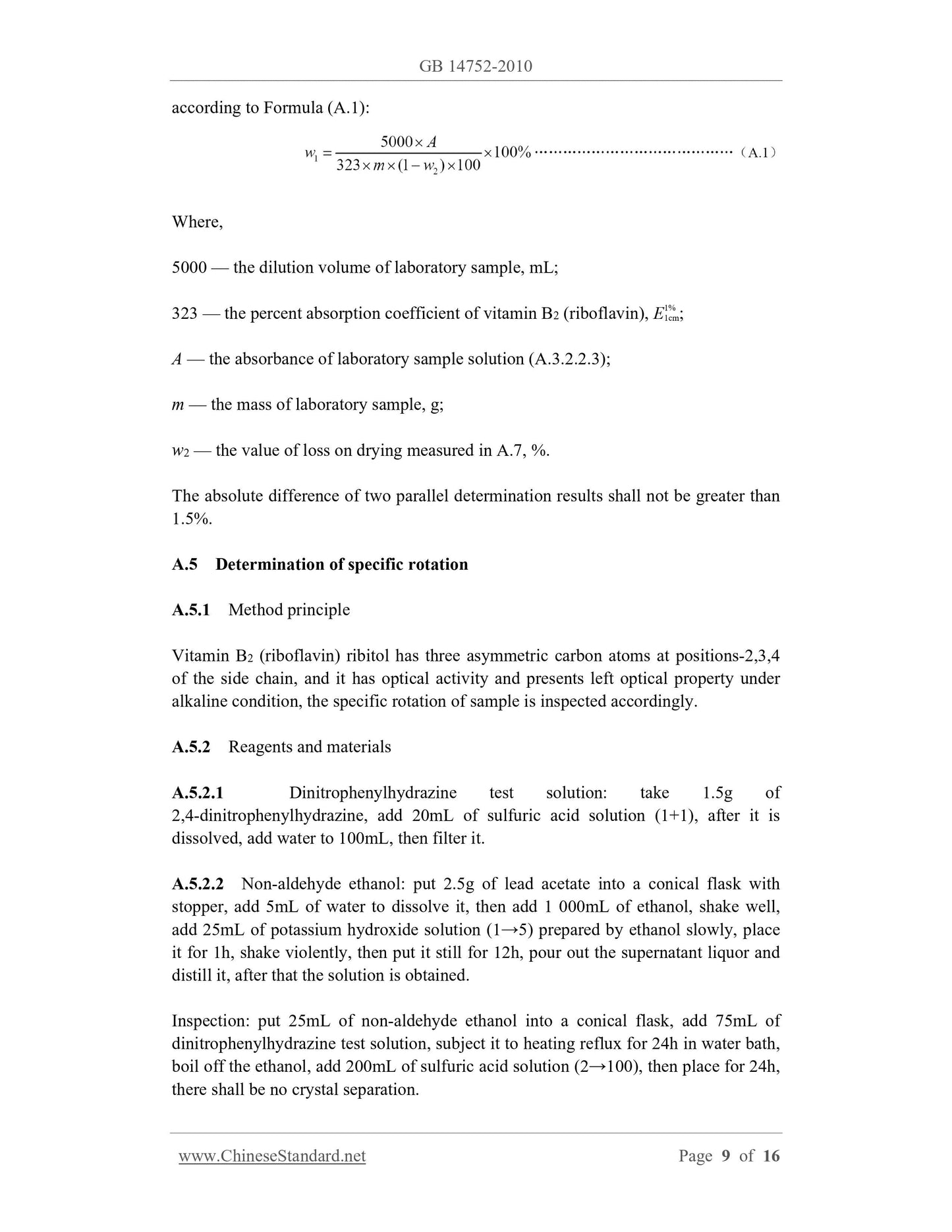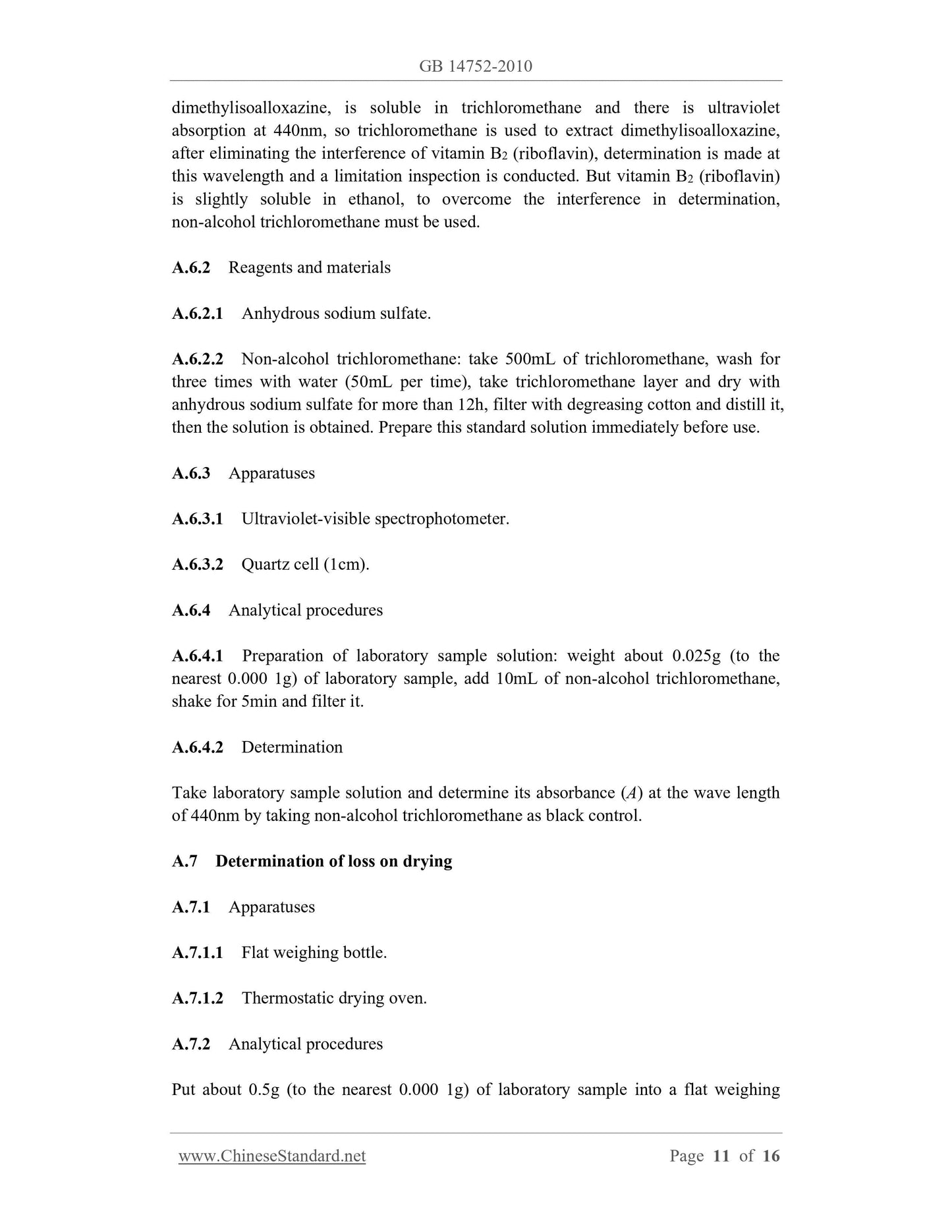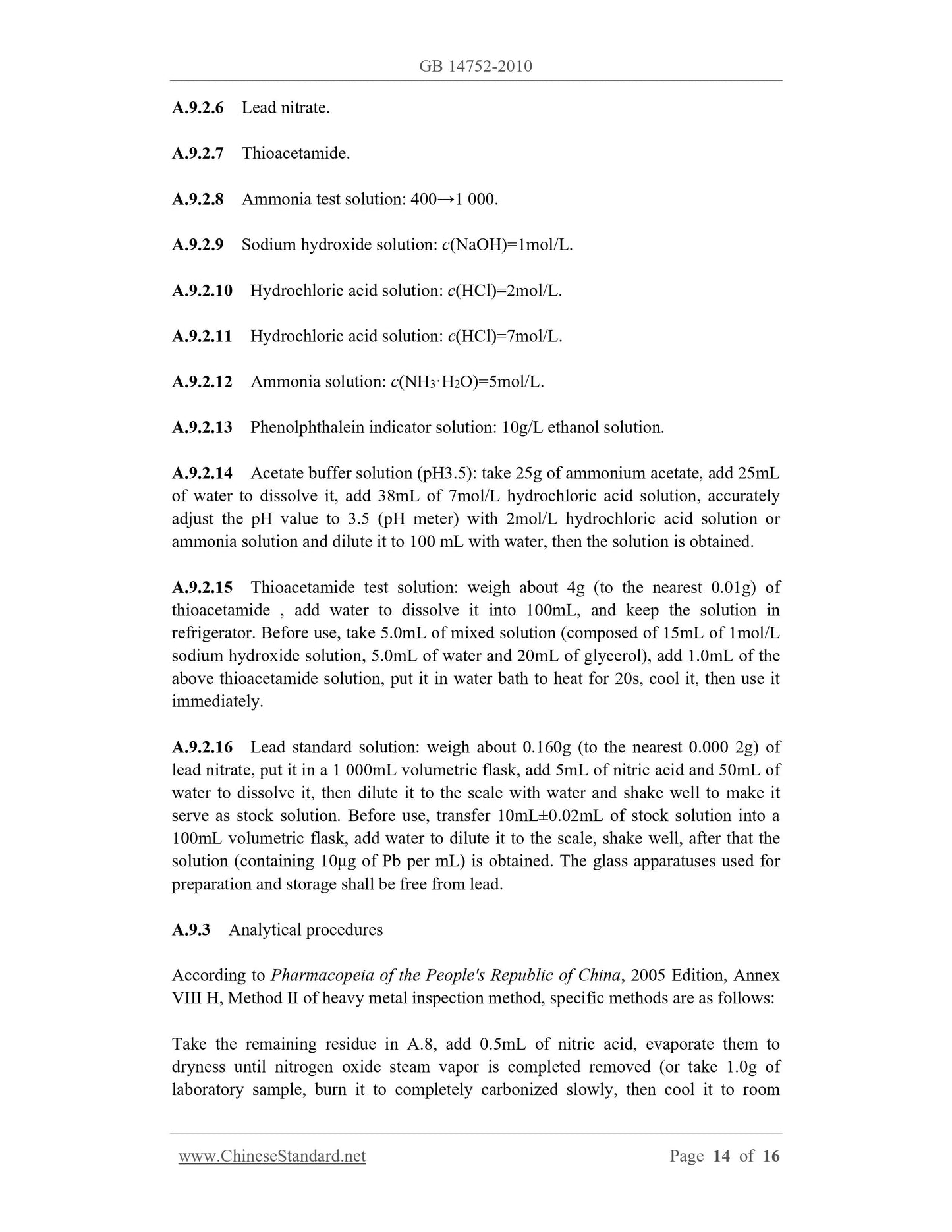1
/
de
8
PayPal, credit cards. Download editable-PDF and invoice in 1 second!
GB 14752-2010 English PDF (GB14752-2010)
GB 14752-2010 English PDF (GB14752-2010)
Prix habituel
$230.00 USD
Prix habituel
Prix promotionnel
$230.00 USD
Prix unitaire
/
par
Frais d'expédition calculés à l'étape de paiement.
Impossible de charger la disponibilité du service de retrait
Delivery: 3 seconds. Download true-PDF + Invoice.
Get QUOTATION in 1-minute: Click GB 14752-2010
Historical versions: GB 14752-2010
Preview True-PDF (Reload/Scroll if blank)
GB 14752-2010: National food safety standards -- Food additives -- Vitamin B2 (riboflavin)
GB 14752-2010
GB
National Standard of the People’s Republic of China
National Food Safety Standard - Food Additive - Vitamin B2
(Riboflavin)
ISSUED ON: DECEMBER 21, 2010
IMPLEMENTED ON: FEBRUARY 21, 2011
Issued by: Ministry of Health of the People’s Republic of China
Table of Contents
Foreword ... 3
1 Scope ... 4
2 Normative References ... 4
3 Chemical Name, Molecular Formula, Structural Formula and Relative Molecular
Mass ... 4
4 Technical Requirements ... 5
Annex A (Normative) Inspection Methods ... 6
Annex B (Normative) Infrared Absorption Spectrum of Vitamin B2 ... 16
National Food Safety Standard - Food Additive -
Vitamin B2 (Riboflavin)
1 Scope
This standard is applicable to the food additive - vitamin B2 (riboflavin) prepared by
chemical synthesis method and bio-fermentation.
2 Normative References
The following referenced documents are indispensable for the application of this
standard. For dated references, only the edition cited applies. For undated references,
the latest edition of the referenced document (including any amendments) applies.
3 Chemical Name, Molecular Formula, Structural
Formula and Relative Molecular Mass
3.1 Chemical name
7,8-dimethyl-10-[(2S,3S,4R)-2,3,4,5-tetrahydroxypentyl]-3,10-benzo[g]pteridine-2,4-
dione
3.2 Molecular formula
C17H20N4O6
3.3 Structural formula
3.4 Relative molecular mass
Annex A
(Normative)
Inspection Methods
A.1 Safety warning
Some reagents used in the inspection methods of this standard are toxic or corrosive,
therefore the operator shall operate according to the relevant requirements carefully.
In case of splashing to skin, flush with water immediately, where the situation is
serious, seek treatment immediately. Volatile acid, if required, shall be used in fume
cupboard.
A.2 General requirements
Unless otherwise specified, analytically pure reagents and Grade 3 water (specified in
GB/T 6682-2008) shall be used in this standard. Unspecified solution is aqueous
solution.
If there is no requirement, standard titration solution and other required solutions used
in test shall be prepared according to those specified in GB/T 601, GB/T 602 and
GB/T 603.
A.3 Identification test
A.3.1 Fluorescence test
A.3.1.1 Method principle
Vitamin B2 (riboflavin) contains aromatic ring and heterocyclic ring, and has
transition of π→π* of long conjugated structure and fluorescence. Vitamin B2
(riboflavin) will be changed into non-fluorescent substance under acid and alkaline
conditions and when any reducer is added.
A.3.1.2 Reagents and materials
A.3.1.2.1 Hydrochloric acid solution: 1+2.
A.3.1.2.2 Sodium hydroxide solution: 40g/L.
A.3.1.2.3 Sodium hydrosulfite.
A.3.1.3 Analytical procedures
Take about 1mg of laboratory sample, dissolve it in 100mL of water, then the solution
is yellowish green and has strong yellowish green fluorescence under transmission
light; divide the solution into two portions: add hydrochloric acid solution or sodium
hydroxide solution in one portion, then the fluorescence is disappeared; add a small
amount of sodium hydrosulfite in the other portion and shake well, then the yellow
fades and fluorescence disappears too.
A.3.2 Identification by ultraviolet-visible absorption spectrum
A.3.2.1 Method principle
Vitamin B2 (riboflavin) has a benzene ring structure and multiple conjugated double
bonds, in its ultraviolet - visible absorption spectrum, there are three absorption peaks
(444nm, 375nm and 267nm), vitamin B2 (riboflavin) is identified according to the
ratio of A444nm/A267nm and A375nm/A267nm.
A.3.2.2 Reagents and materials
A.3.2.2.1 Glacial acetic acid.
A.3.2.2.2 Sodium acetate solution: 14g/L.
A.3.2.2.3 Laboratory sample solution: operate in a dark place. Put about 0.075g (to
the nearest 0.001g) of laboratory sample into a beaker, add 1mL of glacial acetic acid
and 75mL of water, heat them until they are dissolved, dilute the solution with water
and cool to room temperature, then transfer it into a 500mL brown volumetric flask,
dilute it to the scale with water, and shake well; exactly measure 10mL and put it in a
100mL brown volumetric flask, add into 7mL of sodium acetate solution, dilute to the
scale with water and shake well.
A.3.2.3 Apparatuses
A.3.2.3.1 Ultraviolet-visible spectrophotometer.
A.3.2.3.2 Quartz cell (1cm).
A.3.2.4 Analytical procedures
Scan the laboratory sample solution, it is found that the maximum absorptions exist at
wavelengths of 444nm±1nm, 375nm±1nm and 267nm±1nm; and determine the
absorbance (A), and calculate the ratio of A375nm/A267nm to be 0.31~0.33 and
according to Formula (A.1):
Where,
5000 — the dilution volume of laboratory sample, mL;
323 — the percent absorption coefficient of vitamin B2 (riboflavin), E1% 1cm;
A — the absorbance of laboratory sample solution (A.3.2.2.3);
m — the mass of laboratory sample, g;
w2 — the value of loss on drying measured in A.7, %.
The absolute difference of two parallel determination results shall not be greater than
1.5%.
A.5 Determination of specific rotation
A.5.1 Method principle
Vitamin B2 (riboflavin) ribitol has three asymmetric carbon atoms at positions-2,3,4
of the side chain, and it has optical activity and presents left optical property under
alkaline condition, the specific rotation of sample is inspected accordingly.
A.5.2 Reagents and materials
A.5.2.1 Dinitrophenylhydrazine test solution: take 1.5g of
2,4-dinitrophenylhydrazine, add 20mL of sulfuric acid solution (1+1), after it is
dissolved, add water to 100mL, then filter it.
A.5.2.2 Non-aldehyde ethanol: put 2.5g of lead acetate into a conical flask with
stopper, add 5mL of water to dissolve it, then add 1 000mL of ethanol, shake well,
add 25mL of potassium hydroxide solution (1→5) prepared by ethanol slowly, place
it for 1h, shake violently, then put it still for 12h, pour out the supernatant liquor and
distill it, after that the solution is obtained.
Inspection: put 25mL of non-aldehyde ethanol into a conical flask, add 75mL of
dinitrophenylhydrazine test solution, subject it to heating reflux for 24h in water bath,
boil off the ethanol, add 200mL of sulfuric acid solution (2→100), then place for 24h,
there shall be no crystal separation.
dimethylisoalloxazine, is soluble in trichloromethane and there is ultraviolet
absorption at 440nm, so trichloromethane is used to extract dimethylisoalloxazine,
after eliminating the interference of vitamin B2 (riboflavin), determination is made at
this wavelength and a limitation inspection is conducted. But vitamin B2 (riboflavin)
is slightly soluble in ethanol, to overcome the interference in determination,
non-alcohol trichloromethane must be used.
A.6.2 Reagents and materials
A.6.2.1 Anhydrous sodium sulfate.
A.6.2.2 Non-alcohol trichloromethane: take 500mL of trichloromethane, wash for
three times with water (50mL per time), take trichloromethane layer and dry with
anhydrous sodium sulfate for more than 12h, filter with degreasing cotton and distill it,
then the solution is obtained. Prepare this standard solution immediately before use.
A.6.3 Apparatuses
A.6.3.1 Ultraviolet-visible spectrophotometer.
A.6.3.2 Quartz cell (1cm).
A.6.4 Analytical procedures
A.6.4.1 Preparation of laboratory sample solution: weight about 0.025g (to the
nearest 0.000 1g) of laboratory sample, add 10mL of non-alcohol trichloromethane,
shake for 5min and filter...
Get QUOTATION in 1-minute: Click GB 14752-2010
Historical versions: GB 14752-2010
Preview True-PDF (Reload/Scroll if blank)
GB 14752-2010: National food safety standards -- Food additives -- Vitamin B2 (riboflavin)
GB 14752-2010
GB
National Standard of the People’s Republic of China
National Food Safety Standard - Food Additive - Vitamin B2
(Riboflavin)
ISSUED ON: DECEMBER 21, 2010
IMPLEMENTED ON: FEBRUARY 21, 2011
Issued by: Ministry of Health of the People’s Republic of China
Table of Contents
Foreword ... 3
1 Scope ... 4
2 Normative References ... 4
3 Chemical Name, Molecular Formula, Structural Formula and Relative Molecular
Mass ... 4
4 Technical Requirements ... 5
Annex A (Normative) Inspection Methods ... 6
Annex B (Normative) Infrared Absorption Spectrum of Vitamin B2 ... 16
National Food Safety Standard - Food Additive -
Vitamin B2 (Riboflavin)
1 Scope
This standard is applicable to the food additive - vitamin B2 (riboflavin) prepared by
chemical synthesis method and bio-fermentation.
2 Normative References
The following referenced documents are indispensable for the application of this
standard. For dated references, only the edition cited applies. For undated references,
the latest edition of the referenced document (including any amendments) applies.
3 Chemical Name, Molecular Formula, Structural
Formula and Relative Molecular Mass
3.1 Chemical name
7,8-dimethyl-10-[(2S,3S,4R)-2,3,4,5-tetrahydroxypentyl]-3,10-benzo[g]pteridine-2,4-
dione
3.2 Molecular formula
C17H20N4O6
3.3 Structural formula
3.4 Relative molecular mass
Annex A
(Normative)
Inspection Methods
A.1 Safety warning
Some reagents used in the inspection methods of this standard are toxic or corrosive,
therefore the operator shall operate according to the relevant requirements carefully.
In case of splashing to skin, flush with water immediately, where the situation is
serious, seek treatment immediately. Volatile acid, if required, shall be used in fume
cupboard.
A.2 General requirements
Unless otherwise specified, analytically pure reagents and Grade 3 water (specified in
GB/T 6682-2008) shall be used in this standard. Unspecified solution is aqueous
solution.
If there is no requirement, standard titration solution and other required solutions used
in test shall be prepared according to those specified in GB/T 601, GB/T 602 and
GB/T 603.
A.3 Identification test
A.3.1 Fluorescence test
A.3.1.1 Method principle
Vitamin B2 (riboflavin) contains aromatic ring and heterocyclic ring, and has
transition of π→π* of long conjugated structure and fluorescence. Vitamin B2
(riboflavin) will be changed into non-fluorescent substance under acid and alkaline
conditions and when any reducer is added.
A.3.1.2 Reagents and materials
A.3.1.2.1 Hydrochloric acid solution: 1+2.
A.3.1.2.2 Sodium hydroxide solution: 40g/L.
A.3.1.2.3 Sodium hydrosulfite.
A.3.1.3 Analytical procedures
Take about 1mg of laboratory sample, dissolve it in 100mL of water, then the solution
is yellowish green and has strong yellowish green fluorescence under transmission
light; divide the solution into two portions: add hydrochloric acid solution or sodium
hydroxide solution in one portion, then the fluorescence is disappeared; add a small
amount of sodium hydrosulfite in the other portion and shake well, then the yellow
fades and fluorescence disappears too.
A.3.2 Identification by ultraviolet-visible absorption spectrum
A.3.2.1 Method principle
Vitamin B2 (riboflavin) has a benzene ring structure and multiple conjugated double
bonds, in its ultraviolet - visible absorption spectrum, there are three absorption peaks
(444nm, 375nm and 267nm), vitamin B2 (riboflavin) is identified according to the
ratio of A444nm/A267nm and A375nm/A267nm.
A.3.2.2 Reagents and materials
A.3.2.2.1 Glacial acetic acid.
A.3.2.2.2 Sodium acetate solution: 14g/L.
A.3.2.2.3 Laboratory sample solution: operate in a dark place. Put about 0.075g (to
the nearest 0.001g) of laboratory sample into a beaker, add 1mL of glacial acetic acid
and 75mL of water, heat them until they are dissolved, dilute the solution with water
and cool to room temperature, then transfer it into a 500mL brown volumetric flask,
dilute it to the scale with water, and shake well; exactly measure 10mL and put it in a
100mL brown volumetric flask, add into 7mL of sodium acetate solution, dilute to the
scale with water and shake well.
A.3.2.3 Apparatuses
A.3.2.3.1 Ultraviolet-visible spectrophotometer.
A.3.2.3.2 Quartz cell (1cm).
A.3.2.4 Analytical procedures
Scan the laboratory sample solution, it is found that the maximum absorptions exist at
wavelengths of 444nm±1nm, 375nm±1nm and 267nm±1nm; and determine the
absorbance (A), and calculate the ratio of A375nm/A267nm to be 0.31~0.33 and
according to Formula (A.1):
Where,
5000 — the dilution volume of laboratory sample, mL;
323 — the percent absorption coefficient of vitamin B2 (riboflavin), E1% 1cm;
A — the absorbance of laboratory sample solution (A.3.2.2.3);
m — the mass of laboratory sample, g;
w2 — the value of loss on drying measured in A.7, %.
The absolute difference of two parallel determination results shall not be greater than
1.5%.
A.5 Determination of specific rotation
A.5.1 Method principle
Vitamin B2 (riboflavin) ribitol has three asymmetric carbon atoms at positions-2,3,4
of the side chain, and it has optical activity and presents left optical property under
alkaline condition, the specific rotation of sample is inspected accordingly.
A.5.2 Reagents and materials
A.5.2.1 Dinitrophenylhydrazine test solution: take 1.5g of
2,4-dinitrophenylhydrazine, add 20mL of sulfuric acid solution (1+1), after it is
dissolved, add water to 100mL, then filter it.
A.5.2.2 Non-aldehyde ethanol: put 2.5g of lead acetate into a conical flask with
stopper, add 5mL of water to dissolve it, then add 1 000mL of ethanol, shake well,
add 25mL of potassium hydroxide solution (1→5) prepared by ethanol slowly, place
it for 1h, shake violently, then put it still for 12h, pour out the supernatant liquor and
distill it, after that the solution is obtained.
Inspection: put 25mL of non-aldehyde ethanol into a conical flask, add 75mL of
dinitrophenylhydrazine test solution, subject it to heating reflux for 24h in water bath,
boil off the ethanol, add 200mL of sulfuric acid solution (2→100), then place for 24h,
there shall be no crystal separation.
dimethylisoalloxazine, is soluble in trichloromethane and there is ultraviolet
absorption at 440nm, so trichloromethane is used to extract dimethylisoalloxazine,
after eliminating the interference of vitamin B2 (riboflavin), determination is made at
this wavelength and a limitation inspection is conducted. But vitamin B2 (riboflavin)
is slightly soluble in ethanol, to overcome the interference in determination,
non-alcohol trichloromethane must be used.
A.6.2 Reagents and materials
A.6.2.1 Anhydrous sodium sulfate.
A.6.2.2 Non-alcohol trichloromethane: take 500mL of trichloromethane, wash for
three times with water (50mL per time), take trichloromethane layer and dry with
anhydrous sodium sulfate for more than 12h, filter with degreasing cotton and distill it,
then the solution is obtained. Prepare this standard solution immediately before use.
A.6.3 Apparatuses
A.6.3.1 Ultraviolet-visible spectrophotometer.
A.6.3.2 Quartz cell (1cm).
A.6.4 Analytical procedures
A.6.4.1 Preparation of laboratory sample solution: weight about 0.025g (to the
nearest 0.000 1g) of laboratory sample, add 10mL of non-alcohol trichloromethane,
shake for 5min and filter...
Share
